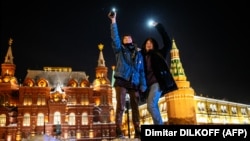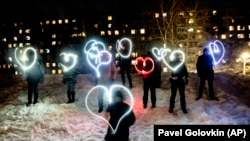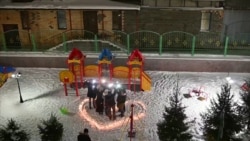When Russians took to the streets three times in recent weeks to protest the jailing of Kremlin opponent Aleksei Navalny, police violently dispersed the crowds and detained more than 11,000 people. But the latest nationwide demonstration, on February 14, provoked hardly any clashes or arrests.
That was one of the goals of the Valentine's Day gatherings, which saw residents of numerous cities brave subzero temperatures to hold flashlights in the courtyards of their apartment buildings, silently expressing opposition to President Vladimir Putin's government while showing solidarity with Navalny and other activists swept up in the crackdown.
Absent were the chants -- "Putin is a thief!" and "Down with the tsar!" -- that echoed through town squares at rallies across Russia on January 23 and 31 and in Moscow and St. Petersburg on February 2. Police mostly stayed away despite advance warnings that formed part of a concerted state effort to keep people from taking part.
Thousands posted selfies online, boosting the hashtag #любовьсильнеестраха (#LoveIsStrongerThanFear) to the top of the Russian-language segments of Twitter and Instagram.
But the diffuse nature of the flashlight protest, and the difficulty of gauging how many joined them, provoked mixed responses as to what impact they could have in a country where many of the key opposition activists are under house arrest or in jail, with many wondering whether such demonstrations can maintain momentum in the months before parliamentary elections in which Navalny's allies hope to challenge the ruling United Russia party.
Putin's spokesman, Dmitry Peskov, seized on the lack of reliable turnout figures to suggest the low-key demonstrations had little impact. "Yes, some people walked around with flashlights," he told reporters on February 15. "Wonderful."
"It wasn't a failure, but you can't exactly call it a success either," Abbas Gallyamov, a former Kremlin speechwriter and now political analyst, told RFE/RL. "It seems not that many people came out."
Ivan Zhdanov, the director of Navalny's Anti-Corruption Foundation, suggested on February 15 that based on the thousands of social-media posts, tens of thousands of people had come out.
Vladislav Inozemtsev, an economist and political analyst who is a critic of Putin, said that if just a few residents from thousands of apartment buildings came out, the total numbers may have been similar to the 100,000 estimated at protests on January 23 and 31.
'No OMON, No Fear'
The opposition has had a tough time in recent weeks. Following a particularly violent crackdown on the recent protests, and Navalny's sentencing to more than 2 1/2 years in prison on February 2, activists issued a controversial statement calling for a halt to street rallies until the spring and urging supporters to dig in for a protracted political campaign that would culminate with the September elections to the State Duma, the lower house of parliament.
So it came as a surprise to some when Leonid Volkov, who runs Navalny's network of campaign offices across Russia, announced the flashlight demonstrations as an alternative show of anger against the state.
"Let's have social-media feeds filled with thousands of shining hearts from dozens of Russian cities," Volkov wrote on Facebook on February 9. "No OMON [riot police], no fear."
The unorthodox protest was initiated by Navalny's team as a way of circumventing the authorities' readiness to deploy violence and overcoming the fear it instilled. It was also a way of keeping up momentum in the face of the authorities' campaign to break it through force, through TV propaganda, and by organizing counter-rallies featuring participants professing their ostensible respect and admiration for Putin.
Inozemtsev said that the Valentine's Day initiative had greater symbolic appeal than large street protests and that it reached more people because it took place in neighborhoods across cities, including on their outskirts, not just in the center.
"The number of people who saw what was taking place was immeasurably greater than the number that directly observed the protests on recent weekends," he wrote on Facebook. "In other words, as a symbolic act the initiative turned out to be very successful."
Many participants voiced the same sentiment, revealing hopes that despite its more understated nature, the series of flashlight demonstrations would send a message that would resonate across the country and recruit even more activists to the protest cause.
"I went out alone. It was predictable, I expected nothing else," Yekaterina Khramtsova, an activist in the Urals city of Chelyabinsk, wrote on Twitter. "And if just one person walked past or looked out of their window and paused to think, then all this wasn’t in vain."




















